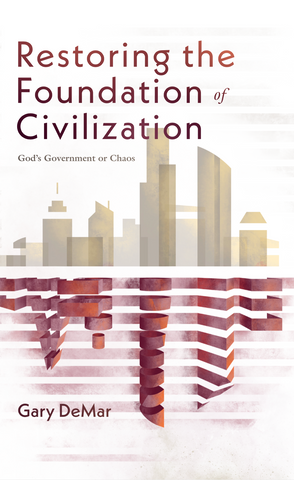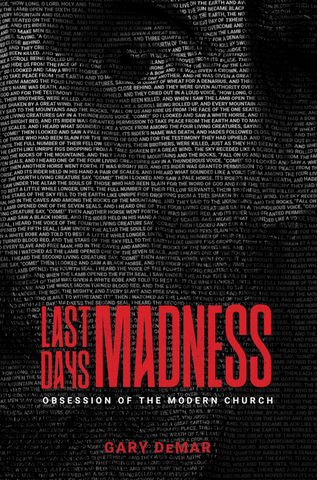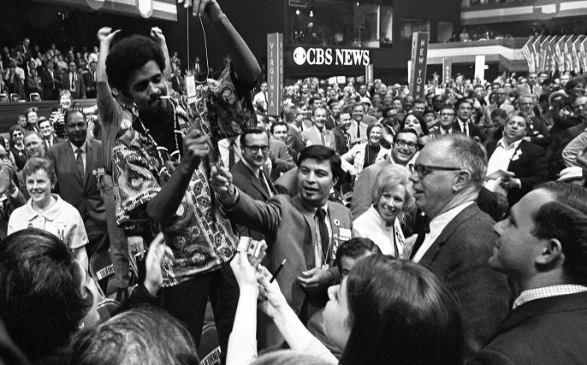George Will called 1968 “perhaps the worst year in American History” and called the sixties “the most dangerous decade in America’s life as a nation.” [1] This is not surprising because of the continued escalation of the Vietnam War, the draft, and the assassinations of Martin Luther King, Jr., and Robert F. Kennedy. These events happened a year after the “Summer of Love” that began in the Haight-Ashbury district of San Francisco that became the epicenter of the counterculture movement that included psychedelic music, a radical change in fashion, and a rapid transformation of sexual mores that affected the youth culture of that era.
The year 1969 was said to be a pivotal turning point year for America. Abbie Hoffman named it “The Woodstock Nation” after the Woodstock Music & Art Fair that brought together half a million people for a three-day celebration of “peace and love” that happened in New York that year when more than 500,000 music fans showed up for an outdoor concert. Joni Mitchell’s song “Woodstock,” later covered by Crosby, Stills, and Nash mentions getting “back to the garden,” a subtle reference to the Garden of Eden. The euphoria was short-lived, however.
The supposed “spiritual counter cultural awakening” at Woodstock in 1969 dimmed quickly after the fiasco at the Altamont Speedway Free Festival—dubbed “Woodstock West”—“remembered for considerable violence, including the stabbing death of Meredith Hunter and three accidental deaths: two by a hit-and-run car accident, and one by an LSD-induced drowning in an irrigation canal. Scores were injured, numerous cars were stolen (and subsequently abandoned) and there was extensive property damage.” Rolling Stone magazine termed the event as “rock and roll’s all-time worst day, December 6th, a day when everything went perfectly wrong.”[2] The final blow to the “happy nihilism” of the 1960s came on May 4, 1970, when the National Guard opened fire at an antiwar protest at Kent State University and four people were killed and later immortalized in the Crosby, Stills, Nash, and Young protest song “Ohio.” Two questions remain:
- Where did all the radicals go after the Kent State Shootings?
- Where did all the Christians go after the publication of Hal Lindsey’s The Late Great Planet Earth in 1970, a book that was the most popular non-fiction book of the 1970s?
The strategy changed from “burn, baby burn” among groups like the SDS and the Weather Underground to a long march through the ruling institutions. Instead of burning them down, they would infiltrate them and take them over. Roger Kimball captures the tactic well in his book The Long March: How the Cultural Revolution of the 1960s Changed America: “The long march through the institutions signified in the words of [Herbert] Marcuse, ‘working against the established institutions while working in them’. By this means—by insinuation and infiltration rather than by confrontation—the counter-cultural dreams of radicals like Marcuse have triumphed.”[3]

Restoring the Foundation of Civilization
The main reason anti-Christian civilizationists survive and seem to thrive is that Christians have not engaged with, answered, and built a competing alternative culture—THE ORIGINAL CIVILIZATION—founded on the principles found in God’s Word and observable in creation. Moreover, many Christians don’t believe there can be or should be a Christian civilization, so they send their children off to the local government school that is anti-Christian believing that facts are neutral and public education is free. Such thinking comes at a terrible cost.
Buy NowBefore Saul Alinsky and his 1971 tactical book Rules for Radicals [4] and Marcuse there was Antonio Gramsci (1891-1937). Gramsci considered Christianity to be the “force binding all the classes—peasants and workers and princes, priests and popes and all the rest besides, into a single, homogeneous culture. It was specifically Christian culture, in which individual men and women understood that the most important things about human life transcend the material conditions in which they lived out their mortal lives.”[5] Gramsci broke with Marx and Lenin’s belief that the masses would arise and overthrow the ruling “superstructure.” No matter how oppressed the working classes might be, their Christian faith would not allow such an overthrow, Gramsci theorized. Marxists taught “that everything valuable in life was within mankind.”[6] Like Yuval Noah Harari after them, it’s all biology and mountains.
After building their new coalition “they must enter into every civil, cultural and political activity in every nation, patiently leavening them all as thoroughly as yeast leavens bread.”[7] To change the culture, Gramsci argued, “would require a ‘long march through the institutions’—the arts, cinema, theater, schools, colleges, seminaries, newspapers, magazines, and the new electronic medium [of the time], radio.”[8]
The American Left is trying to destroy our nation in hopes of building a new one by capitulating to what they believe are common goals with radical Islamists and by undermining the core values of America through the tactics set forth by Alinsky in Rules for Radicals. It was Alinsky who wrote, “Do one of three things. One, go find a wailing wall and feel sorry for yourselves. Two, go psycho and start bombing—but this will only swing people to the right. Three, learn a lesson. Go home, organize, build power and at the next convention, you be the delegates.”[9]
The case could be made that because of our limited application of the Bible to our world that we have left a worldview vacuum that has been filled by those who have a competing book of values and who rightfully believe that there is no such thing as neutrality. Dr. Gary North (1942-2022) had two impactful pieces of advice.
- You can’t beat something with nothing.
- You can’t change just one thing.
Jesus warned His disciples not to be led astray by traditions that have the effect of setting “aside the commandment of God” (Mark 7:9). Paul cautioned the “elders of the church” at Ephesus that after his departure “savage wolves will come in among you, not sparing the flock; and from among your own selves men will arise, speaking perverse things, to draw away the disciples after them” (Acts 20:17, 29-30). It’s no less true today than in John’s day that “many false prophets have gone out into the world” (1 John 4:1), many of whom “went out from us” (2:19).
Jesus saved his harshest criticism for the religious leaders of Israel for the simple reason that they are religious leaders who carry the weight of authority with their words (Matt. 21:23–46; 23:2–3; James 3:1). Jesus told Nicodemus, who was “the teacher of Israel,” that he should have understood basic theological truths (John 3:10). While a false doctrine has the outward appearance of orthodoxy, in terms of what the Bible tells us, it has a soft and oftentimes rotten core (Matt. 23:25-28) but is presented as Bible truth.
The claim is often made by some well-meaning Christians that the world and the things in the world are off-limits to Christians; that the best way to live the Christian life is not to get involved in “the things of this world.” Holiness is defined as an escape from this world, if not physically through some cataclysmic eschatological event like a rapture,[10] then certainly by being separated from the affairs of this world by an unwillingness to acknowledge that God has made us stewards of His good creation of which He demands an accounting (Matt. 25:14-30). In fact, that accounting has always taken place and continues to do so!
Instead of following the directive of Abraham Kuyper who said, “There is not a square inch in the whole domain of our human existence over which Christ, who is Sovereign over all, does not cry, ‘Mine!,’”[11] Christians often claim, “there is not a square inch in the whole domain of our human existence over which Satan doesn’t say ‘Mine’” based on a terrible misreading of 2 Corinthians 4:4 that states “Satan is the god of this world.”[12] The same Paul who wrote that also wrote, “God will soon crush Satan under your feet” (Rom. 16:20), that is feet of that Apostolic generation. There were many antichrists in John’s day (1 John 2:18, 22). Antichrists were mostly non-believing Jewish religious leaders to rejected Jesus as the promised Messiah (2 John 7).
A popular metaphor for prophetic irrelevance is the sinking Titanic theme. “This metaphor was made famous … by the 1950s radio preacher J. Vernon McGee, who warned his listeners with the rhetorical question, ‘Do you polish brass on a sinking ship?’ Apparently, McGee used the metaphor often, elsewhere referring to the ‘sinking ship of civilization.’”[13] Predicting the end has a long history that has made its way into pop culture, everything from Barry McGuire’s 1965 hit song “Eve of Destruction.” It seemed that way with the Cuban Missile Crisis in 1962, the assassination of President John F. Kennedy in 1963, and the ever-present threat of nuclear war with the former Soviet Union. The culmination of these world changing events and much more led Johnny Cash to perform “Matthew 24 (Is Knocking at the Door)” in 1973.
Matthew 24 is knocking at the door
And there can’t be too much more to come to past,Matthew 24 is knockin’ at the door
and today or one day more could be the last.
Eschatological ideas have consequences, and many Christians are beginning to understand how those ideas have shaped the cultural landscape. A world always on the precipice of some great and inevitable apocalyptic event is not in need of redemption but only of escape. As one end-time speculator put it, “the world is a sinking Titanic ripe for judgment.”

Last Days Madness
In this authoritative book, Gary DeMar clears the haze of "end-times" fever, shedding light on the most difficult and studied prophetic passages in the Bible, including Daniel 7:13-14; 9:24-27; Matt. 16:27-28; 24-25; Thess. 2; 2 Peter 3:3-13, and clearly explaining a host of other controversial topics.
Buy Now[1] George F. Will, “1968: Memories That Dim and Differ,” Washington Post (January 14, 1988), A27.
[2] John Burks, “Rock & Roll’s Worst Day: The aftermath of Altamont,” Rolling Stone (February 7, 1970).
[3] Roger Kimball, The Long March: How the Cultural Revolution of the 1960s Changed America (San Franciso: Encounter Books, 2000), 15.
[4] The Thirteen Rules for Radicals:
1. Power is not only what you have but what the enemy thinks you have.
2. Never go outside the expertise of your people.
3. Whenever possible go outside the expertise of the enemy.
4. Make the enemy live up to its own book of rules.
5. Ridicule is man’s most potent weapon. There is no defense. It is almost impossible to counterattack ridicule. Also, it infuriates the opposition, who then react to your advantage.
6. A good tactic is one your people enjoy.
7. A tactic that drags on too long becomes a drag.
8. Keep the pressure on.
9. The threat is usually more terrifying than the thing itself.
10. The major premise for tactics is the development of operations that will maintain a constant pressure upon the opposition.
11. If you push a negative hard and deep enough it will break through into its counterside; this is based on the principle that every positive has its negative.
12. The price of a successful attack is a constructive alternative.
13. Pick the target, freeze it, personalize it, and polarize it.
[5] Malachi Martin, The Keys of This Blood: The Struggle for World Dominion Between Pope John II, Mikhail Gorbachev and the Capitalist West (New York: Simon and Schuster, 1990), 245.
[6] Martin, The Keys of This Blood, 245.
[7] Martin, The Keys of This Blood, 250.
[8] Patrick J. Buchanan, Death of the West: How Dying Populations and Immigrant Invasions Imperil Our Country and Civilization (New York: St. Martin’s Press/Thomas Dunne Books, 2001), 77.
[9] Saul D. Alinsky, Rules for Radicals: A Pragmatic Primer for Realistic Radicals (New York: Vintage Books, [1971] 1989), xxiii.
[10] See Gary DeMar, The Rapture and the Fig Tree Generation, Last Days Madness: Obsession of the Modern Church, 4th ed. (Powder Springs, GA: American Vision, 1999), Left Behind: Separating Fact From Fiction, updated ed. (Powder Springs, GA: American Vision, 2023), and Wars and Rumors of Wars.
[11] Abraham Kuyper, “Sphere Sovereignty,” in James D. Bratt, ed., Abraham Kuyper: A Centennial Reader (Grand Rapids: Eerdmans, 1998), 488.
[12] Literally it’s “god of this age” (aiōn and not kosmos).
[13] Joel McDurmon, “Do You Polish the Brass on a Sinking Ship?,” Free Republic (October 8, 2010): https://freerepublic.com/focus/f-religion/2603902/posts

